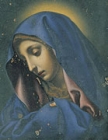本館 特別1室
2009年8月4日(火) ~ 2009年9月6日(日)
東京国立博物館は、541件のキリシタン関係遺品を所蔵しており、その多くが重要文化財に指定され、キリス ト教信仰の歴史をたどる貴重な資料となっています。そのほとんどは長崎奉行所(ながさきぶぎょうしょ)が信徒から没収した品で、明治12年(1879)に 内務省社寺局(ないむしょうしゃじきょく)から当館に引き継がれたものです。今回は、聖母像(マリア像)を表わした作品を中心に展示します。
天文18年(1549)、宣教師フランシスコ・ザビエルがキリスト教布教のため来日した際、多くの聖母の絵を携えていました。その後、イエズス会のア レッサンドロ・ヴァリニャーノがイタリア人画家ニコラオを迎えて絵画学校を開くと日本人による聖像の制作がはじまり、日本ではとくに聖母像が大切にされま した。そして慶長19年(1614)、徳川家康により禁教令が出され、聖像の所持が禁止されると、信者は、子安観音(こやすかんのん)などの仏像を聖母に 見立てた、いわゆる「マリア観音」に祈りを捧げました。キリスト教布教とともにもたらされ、国内でも制作されるようになった聖母像は、信仰を禁じられても なお、崇敬されたのです。
聖母像は、さまざまな遺物に表されています。日本に潜入して捕らえられた宣教師シドッチが持っていたとされる「親指のマリア」や、「マリア観音」、隠れ キリシタンの摘発に用いた踏絵などです。さらに今回は、明治時代にドイツからもたらされた石膏のマリア像や、下村観山がロンドンで写したラファエロの聖母 像をご紹介します。聖母像の日本への「到来」と、その後の深い信仰に、より多くの興味や関心を向けていただければ幸いです。
天文18年(1549)、宣教師フランシスコ・ザビエルがキリスト教布教のため来日した際、多くの聖母の絵を携えていました。その後、イエズス会のア レッサンドロ・ヴァリニャーノがイタリア人画家ニコラオを迎えて絵画学校を開くと日本人による聖像の制作がはじまり、日本ではとくに聖母像が大切にされま した。そして慶長19年(1614)、徳川家康により禁教令が出され、聖像の所持が禁止されると、信者は、子安観音(こやすかんのん)などの仏像を聖母に 見立てた、いわゆる「マリア観音」に祈りを捧げました。キリスト教布教とともにもたらされ、国内でも制作されるようになった聖母像は、信仰を禁じられても なお、崇敬されたのです。
聖母像は、さまざまな遺物に表されています。日本に潜入して捕らえられた宣教師シドッチが持っていたとされる「親指のマリア」や、「マリア観音」、隠れ キリシタンの摘発に用いた踏絵などです。さらに今回は、明治時代にドイツからもたらされた石膏のマリア像や、下村観山がロンドンで写したラファエロの聖母 像をご紹介します。聖母像の日本への「到来」と、その後の深い信仰に、より多くの興味や関心を向けていただければ幸いです。

